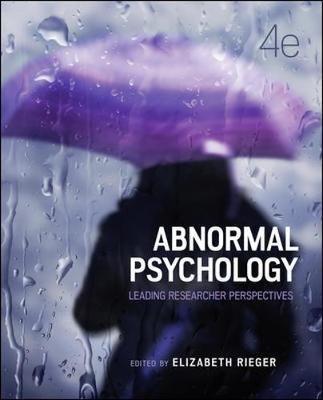In Stock
Test Bank For Abnormal Psychology Leading Researcher perspectives 4th Edition by Rieger
Digital item No Waiting Time Instant DownloadISBN-10: 1743766629 ISBN-13: 978-1743766620
Original price was: $55.00.$20.00Current price is: $20.00.
Test Bank For Abnormal Psychology Leading Researcher perspectives 4th Edition by Rieger
Chapter 02 Test Bank
1. In vicarious acquisition, fear is acquired by:
A. classical conditioning.
B. verbal transmission of fear-related information.
C. observing another person responding with fear to a threat.
D. All of the given options are correct.
E. None of the given options is correct.
Blooms: AnalysisDifficulty: EasyLearning Objective: 2.1 Describe the nature of anxiety and models regarding the aetiology of anxiety disorders.Topic: Anxiety Disorders
2. The most effective treatment for a specific phobia is:
A. counselling.
B. in vivo exposure.
C. imaginal exposure.
D. empathy.
E. conditioning.
Blooms: KnowledgeDifficulty: MediumLearning Objective: 2.2 Describe the diagnostic criteria, epidemiology, aetiology and treatments for specific phobias.Topic: Anxiety Disorders
3. Development of a panic disorder requires:
A. a specific psychological vulnerability.
B. a generalised psychological vulnerability.
C. a generalised biological vulnerability.
D. All of the given options are correct.
E. None of the given options is correct.
Blooms: AnalysisDifficulty: MediumLearning Objective: 2.3 Describe the diagnostic criteria, epidemiology, aetiology and treatments for panic disorder and agoraphobia.Topic: Anxiety Disorders
4. People with social phobia avoid situations because they fear:
A. panic attacks.
B. re-experiencing trauma.
C. contamination by other people.
D. enclosed spaces.
E. embarrassment and negative evaluation by other people.
Blooms: ComprehensionDifficulty: MediumLearning Objective: 2.4 Describe the diagnostic criteria, epidemiology, aetiology and treatments for social anxiety disorder.Topic: Anxiety Disorders
5. Individuals with generalised anxiety disorder (GAD) typically experience worries about:
A. social threat but not physical threat.
B. physical threat but not social threat.
C. both social threat and physical threat.
D. neither social threat nor physical threat.
E. social threat, physical threat and contamination threat.
Blooms: AnalysisDifficulty: MediumLearning Objective: 2.5 Describe the diagnostic criteria, epidemiology, aetiology and treatments for generalised anxiety disorder.Topic: Anxiety Disorders
6. According to Barlow (2002), the hallmark of anxiety is:
A. panic attacks.
B. vicarious acquisition.
C. true alarms.
D. false alarms.
E. distorted thoughts.
Blooms: AnalysisDifficulty: EasyLearning Objective: 2.1 Describe the nature of anxiety and models regarding the aetiology of anxiety disorders.Topic: Anxiety Disorders
7. The Rapee (1991) information processing model of the development of generalised anxiety disorder (GAD) suggests that individuals with GAD selectively attend to:
A. body sensations of impending panic.
B. memories of trauma.
C. stress neurochemicals.
D. threatening information.
E. negative social cues.
Blooms: AnalysisDifficulty: EasyLearning Objective: 2.5 Describe the diagnostic criteria, epidemiology, aetiology and treatments for generalised anxiety disorder.Topic: Anxiety Disorders
8. According to the wells meta-cognitive model of generalised anxiety disorder (GAD), an individual with GAD is likely to have:
A. only positive beliefs about worrying.
B. only negative beliefs about worrying.
C. both positive and negative beliefs about worrying.
D. All of the given options are correct.
E. None of the given options is correct.
Blooms: ComprehensionDifficulty: HardLearning Objective: 2.5 Describe the diagnostic criteria, epidemiology, aetiology and treatments for generalised anxiety disorder.Topic: Anxiety Disorders
9. Research supports the hypothesis that ________ is/are a specific feature of generalised anxiety disorder.
A. intolerance of uncertainty
B. positive meta-beliefs about worrying
C. worry about a few closely related themes
D. over-estimating one’s ability to cope with negative events
E. negative cognitions
Blooms: ComprehensionDifficulty: MediumLearning Objective: 2.5 Describe the diagnostic criteria, epidemiology, aetiology and treatments for generalised anxiety disorder.Topic: Anxiety Disorders
10. Which of the following is not true of benzodiazepine medications in the treatment of generalised anxiety disorder?
A. They quickly reduce anxiety.
B. They produce drug tolerance and dependence.
C. They were frequently prescribed in the past.
D. The anxiety symptoms return after the medication is stopped.
E. The anxiety symptoms do not return after the medication is stopped.
Blooms: AnalysisDifficulty: EasyLearning Objective: 2.5 Describe the diagnostic criteria, epidemiology, aetiology and treatments for generalised anxiety disorder.Topic: Anxiety Disorders

Reviews
There are no reviews yet.